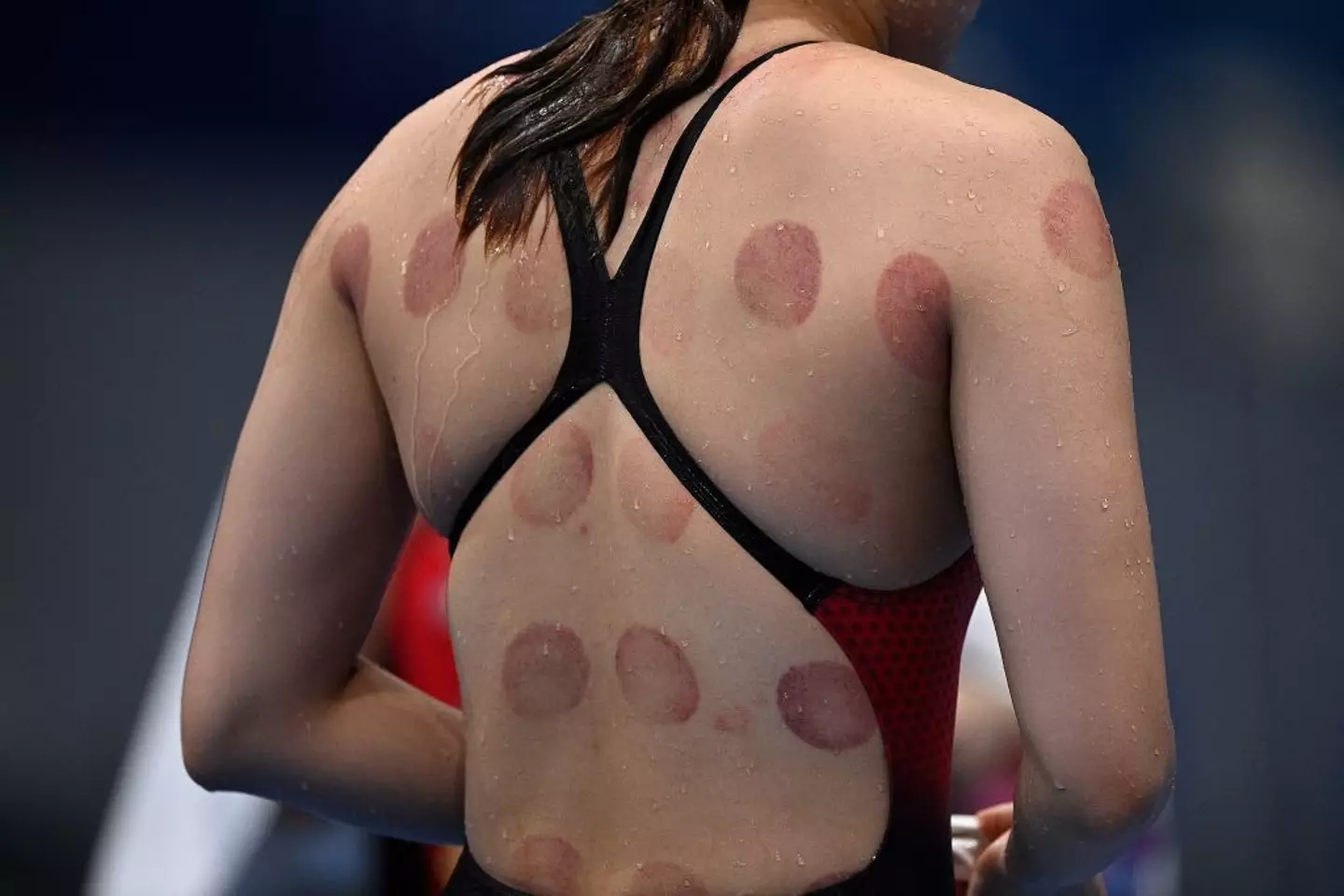
This year’s Olympics are now in full swing and it’s all eyes on the athletes.
From archery and shooting to athletics and gymnastics, there’s all kind of sports taking place across Paris, France, at the moment.
One fan-favorite sport to watch is the swimming, and this year there’s a whopping 854 athletes from 187 different countries competing.
But there’s a common theme you might have spotted with some of the swimmers and that’s the unusual dark red circles they have on their backs.

While it might look like they’ve had a fight with an octopus and lost, there’s a very different reason for the odd markings.
It turns out that the large spots are from cupping therapy – an ancient healing technique that involves placing cups on the skin to create suction and increase blood flow to the area.
The unconventional method is supposed to help with muscle recovery and is used as a type of deep tissue massage.
Some athletes were spotted with cupping therapy bruises back at the Rio Olympics in 2016, and it’s still seemingly popular now.

Gymnast Alexander Naddour told USA Today back in 2016 that cupping was supposedly the ‘secret’ to his health.
He added: “It’s been better than any money I’ve spent on anything else.”
Away from the Games, basketball player Kyle Singler has also praised cupping therapy.
“The bruises do look more intense than what they actually feel like, but the benefit from it is really great,” he previously insisted.
Singler continued to tell Sports Illustrated: “You’re not necessarily getting the immediate response that you might want but over time it does help with recovery and loosening tissue and stuff like that.”
But does cupping therapy actually work according to experts? It’s seems as if the jury’s still out.

According to Harvard Health, some studies have found that cupping might provide some relief for a number of musculoskeletal and sports-related conditions. The quality of this evidence was ‘limited’, however.
Elsewhere a 2022 review found that wet (as opposed to dry cupping) was effective for lower back pain.
While the bruises people get from cupping are pretty gnarly, the therapy is generally seen as safe to practice – even if people aren’t 100 percent on how affective it is.
“Most experts agree that cupping is safe. As long as those treated don’t mind the circular discolorations (which fade over a number of days or weeks), side effects tend to be limited to the pinch experienced during skin suction,” Harvard Health explains.
“It’s quite unusual that cupping causes any serious problems (though, rarely, skin infections have been reported).”
There you have it, folks.
Minhas madrinhas estavam secretamente passando algo para meu marido em nosso casamento – no final da noite, ele acabou com nosso casamento

Dizem que você não se casa apenas com uma pessoa — você se casa com a família dela. Se ao menos alguém tivesse me avisado o quão verdadeiro isso seria, talvez eu não tivesse acabado em lágrimas, agarrando meu vestido de noiva em um apartamento vazio na noite em que meu marido me acusou da única coisa que eu nunca tinha feito.
Tenho 27 anos e, há seis meses, me mudei para o outro lado do país para ficar com meu noivo, Adam. Aos 29, ele parecia ter tudo planejado — um emprego estável, amigos leais e uma família que o adorava.

Um casal feliz | Fonte: Pexels
Ele cresceu nesta cidadezinha pitoresca onde todos se conheciam, e embora fosse intimidador no começo, eu disse a mim mesma que conseguiria fazer dar certo. Afinal, Adam era tudo para mim. Mudar para cá pareceu o próximo passo natural na nossa história de amor.
O planejamento do casamento foi… uma viagem. Desde o momento em que Adam a pediu em casamento, sua irmã mais velha, Beth, praticamente assumiu o controle. Aos 31 anos, ela tinha esse ar de autoridade que tornava difícil resistir.

Homem pedindo sua namorada em casamento | Fonte: Pexels
“Confie em mim, você vai precisar de ajuda”, ela disse com um sorriso cúmplice quando hesitei. E honestamente? Ela não estava errada. Planejar um casamento é estressante. Além disso, Beth parecia conhecer todo mundo na cidade — floristas, fotógrafos, até mesmo o cara que fez os convites personalizados.
Foi como ter meu próprio planejador de casamentos em uma cidade pequena.
Ainda assim, algo pareceu estranho quando Beth casualmente insistiu que suas amigas de infância, Sarah, Kate e Olivia, fossem minhas madrinhas, apesar de eu mal conhecê-las.
“Eles são família”, Beth explicou. “Eles vão tornar sua vida mais fácil.”

Planejador de casamento e noiva conversando | Fonte: Midjourney
Olhando para trás, esse pode ter sido meu primeiro erro.
A decisão de deixar Beth e suas amigas serem minhas madrinhas não foi algo que tomei levianamente. Parecia estranho, entregar um papel tão íntimo a pessoas que eu mal conhecia.
Mas Beth tinha um jeito de fazer as coisas parecerem razoáveis. “Você ainda não tem muita gente aqui”, ela disse, dando um tapinha na minha mão como uma irmã mais velha. “Deixe-nos ajudar. Isso deixará Adam feliz também.”
Então, eu concordei.

Mulheres conversando | Fonte: Mdijourney
O dia do casamento começou como um sonho. O sol beijava o horizonte enquanto eu me arrumava, o local brilhava com luzes suaves de fada, e meu vestido… ah, meu vestido. Eu vi meu reflexo no espelho e fiquei boquiaberta. Por um momento, tudo pareceu perfeito.
Mas então, havia as damas de honra.
Começou com coisas pequenas. Conversas sussurradas que paravam assim que eu entrava na sala. Olhares trocados entre Sarah e Kate que pareciam estranhos.
Tentei me livrar disso. Talvez eu esteja pensando demais. Era o dia do meu casamento. Eu já tinha o suficiente para fazer sem me preocupar com o comportamento enigmático das madrinhas.

Noiva e suas madrinhas | Fonte: Midjourney
Mas durante a recepção, as coisas ficaram mais estranhas. Enquanto eu conversava com minha tia, peguei Sarah caminhando até Adam. Ela lhe entregou algo — pequeno, embrulhado no que parecia ser papel de seda. Ele deu a ela um rápido aceno e colocou no bolso.
“O que foi isso?”, perguntei a Sarah mais tarde, com a voz leve, mas curiosa.
“Ah, só uma coisa para a lua de mel”, ela disse com uma piscadela. “Você verá.”
Kate estava me provocando sobre o “presente supremo” deles a semana toda, então tentei rir. “Vocês todos são tão misteriosos”, eu disse. Mas, no fundo, um mal-estar se instalou no meu estômago.

Noiva e suas madrinhas conversando | Fonte: Midjourney
Na terceira vez, vi um deles passar algo para Adam, não consegui ignorar. O que eles estavam dando a ele? E por que pareciam tão reservados sobre isso?
A recepção deveria ter sido mágica. Eu deveria estar girando sob as luzes, rindo com Adam, cercada de amor e alegria. Em vez disso, passei metade da noite observando meu marido — o homem com quem eu tinha acabado de prometer passar a eternidade — se afastar cada vez mais de mim.
“Adam, venha dançar comigo!”, eu o chamei em um momento, acenando para ele ir para a pista de dança. Ele hesitou, olhando para Beth, que lhe deu um aceno sutil.

Noivo emocionalmente distante olhando para sua noiva | Fonte: Midjourney
“Em um minuto”, ele disse, seu tom tenso. Então ele se virou para ela e as damas de honra.
Minha melhor amiga, Megan, que estava entre os convidados, se inclinou e sussurrou: “Sou só eu ou seu marido está agindo… estranho?”
Engoli em seco. “Não é só você.”
Na hora em que deveríamos cortar o bolo, a tensão era insuportável. Foi quando Adam agarrou minha mão e me puxou para o lado. Seu rosto estava pálido, seus olhos evitando os meus.

Noivos brigando | Fonte: Midjouney
“Precisamos conversar”, ele disse. Sua voz era baixa.
“Fale sobre o que, Adam”, perguntei, forçando uma risada nervosa.
“Não consigo fazer isso”, ele disse, suas palavras soando como um tapa.
Eu congelei. “Não posso fazer o quê?” Minha voz falhou enquanto o pânico se instalava.
“Este casamento.” Seus olhos finalmente encontraram os meus, e eles estavam cheios de algo que eu não conseguia nomear. Raiva? Tristeza?
Eu senti como se o ar tivesse sido sugado para fora da sala. “Do que você está falando?”
“Eu sei o que você está escondendo.”
“Se escondendo?”, repeti, minha voz aumentando em descrença. “Adam, o que—”

Noivos brigando | Fonte: Midjouney
Ele enfiou a mão no bolso e tirou vários envelopes. Meu sangue gelou enquanto ele expunha o conteúdo: fotos, capturas de tela, até mesmo um recibo.
A primeira foto era minha saindo de um café, rindo com um homem que eu não reconheci. A próxima nos mostrava sentados bem próximos no que parecia ser uma mesa de jantar. Então veio uma foto granulada minha entrando no saguão de um hotel, supostamente com o mesmo homem.
“Adam, eu nunca—”
“Pare de mentir”, ele me interrompeu, jogando no chão uma pilha de capturas de tela impressas.

Apenas para fins ilustrativos | Fonte: Midjourney
Peguei uma, minhas mãos tremendo. Era uma conversa de texto, supostamente entre mim e esse homem misterioso.
Ele : Mal posso esperar para ver você de novo, linda.
Eu : Ontem à noite foi incrível. Mesma hora na semana que vem?
Outra mensagem mostrava planos para uma reunião no hotel, junto com um e-mail de confirmação de um quarto reservado em meu nome.
“Isso é loucura”, sussurrei. “Não sou eu, Adam. Alguém—alguém fingiu isso.”

Noiva emocionada conversando com o noivo | Fonte: Midjourney
Sua risada era amarga e sem humor. “Fingimento? Você espera que eu acredite nisso ?”
Lágrimas turvaram minha visão. “Eu nem conheço esse homem! Adam, por favor, você tem que acreditar em mim!”
Mas ele apenas balançou a cabeça. “Não sei o que é pior — que você acha que sou estúpido o suficiente para cair em suas mentiras ou que você fez isso conosco em primeiro lugar.”
No final da noite, Adam ficou em pé na frente dos convidados e anunciou: “Houve uma mudança de planos. O casamento foi cancelado.”

Noivo emocional | Fonte: Midjourney
Suspiros encheram a sala. Eu não conseguia nem olhar para ninguém enquanto corria para fora do local, meu vestido prendendo nos degraus, lágrimas turvando minha visão. Meu conto de fadas tinha se transformado em um pesadelo público.
Megan correu em minha direção, seu rosto pálido de choque. As decorações outrora lindas se tornaram um borrão enquanto Megan me guiava por grupos de convidados sussurrantes.

Noiva emocional correndo | Fonte: Midjourney
No carro, Megan não fez perguntas. Ela não me pressionou para explicar. Ela apenas me entregou lenços e ficou em silêncio enquanto soluços sacudiam meu corpo. “Como isso aconteceu?” Eu engasguei eventualmente. “O que eu fiz para merecer isso?”
“Você não fez nada”, Megan disse firmemente, sua voz grossa de raiva. “Isso é culpa de Adam. E Beth. E de todos eles. Não de você.”
Mas não parecia assim.

Noiva triste conversando com a amiga no carro | Fonte: Midjourney
Os dias que se seguiram foram uma névoa de miséria. Eu mal comia e mal dormia. Toda vez que fechava os olhos, via o rosto de Adam, frio e implacável.
Minha mãe me deu todo o apoio que eu precisava. “Estou aqui, querida”, ela sussurrou. “Estou com você.”
Eu soluçava em seu ombro, a dor se derramando em ondas. “Mãe, ele não acredita em mim”, eu chorei. “Ele acha que eu sou uma mentirosa, uma trapaceira—”

Mulher emocionada conversando com sua mãe | Fonte: Midjourney
“Então ele não conhece você”, ela disse ferozmente, se afastando para me olhar nos olhos. “E se ele não conhece a mulher incrível que você é, então ele é o idiota, não você.”
Megan também ficou, sua energia protetora como um escudo ao meu redor.
Mas nada aliviou a dor no meu peito. Nada poderia desfazer a humilhação de ser rejeitada no dia do meu casamento.
E então um dia, Sarah ligou.

Mulher ao telefone | Fonte: Midjourney
A voz de Sarah falhou enquanto ela falava, a culpa jorrando pelo telefone como uma confissão que ela guardou por muito tempo. “Beth… ela planejou tudo. As mensagens, as fotos, tudo isso. Foi ideia dela.”
Agarrei o telefone com mais força. “O que você quer dizer com planejou tudo ?” Minha voz era cortante, mas meu coração batia forte em descrença.
“Ela disse que precisava proteger Adam”, disse Sarah. “Ela te chamou de interesseira, disse que você não era boa o suficiente para ele. Ela pensou que se ele se casasse com você, ele se arrependeria para sempre.”

Mulher ao telefone | Fonte: Midjourney
“Protegê-lo?”, repeti, minha voz aumentando. “Me destruindo? Me humilhando na frente de todo mundo?”
“Eu sei. Eu sei”, Sarah disse, lágrimas audíveis em sua voz. “Nós não sabíamos… nós pensamos que ela estava dizendo a verdade. Beth nos mostrou capturas de tela falsas, fotos falsas. Ela disse que você negaria, que você faria gaslighting com Adam se ele te confrontasse. Nós pensamos que estávamos ajudando ele.”
“Você achou que arruinar minha vida ajudaria ?”, perguntei com a voz cheia de raiva.
“Eu não sabia da verdade até depois do casamento”, Sarah disse rapidamente. “Sinto muito. Descobri que Beth contratou alguém para encenar aquelas fotos. E os textos? Ela mesma os fez.”

Mulher falando ao telefone | Fonte: Midjourney
Afundei na cadeira, tremendo enquanto Sarah me enviava as capturas de tela do chat em grupo. Lá estava, em preto e branco: Beth orquestrando tudo. Mensagens detalhando como apresentar as “evidências”, orientando as madrinhas sobre como agir e rindo sobre como eu “nunca veria isso chegando”.
No dia seguinte, quando confrontei Adam com a prova, seu rosto se contraiu. “Beth… fez isso?”, ele perguntou, sua voz vazia. “Por que ela—”
“Ela queria proteger você”, eu disse amargamente, jogando o telefone na mesa. “De mim, aparentemente.”

Mulher e um homem conversando | Fonte: Midjourney
Adam caiu de joelhos, lágrimas escorrendo pelo rosto. “Eu não sabia. Juro que não sabia. Por favor, deixe-me consertar isso. Vou cortar Beth da minha vida — farei qualquer coisa. Só me dê outra chance.”
Mas eu não conseguia. A escolha dele de acreditar neles em vez de mim, de me humilhar sem nem ouvir meu lado, tinha quebrado algo muito profundo para consertar.
“Não posso, Adam”, eu disse calmamente. “Você não confiou em mim quando mais importava. E não posso construir uma vida com base nisso.”

Mulher e um homem conversando | Fonte: Midjourney
Poucos dias depois, arrumei minhas coisas, deixei a cidade e voltei para casa, para minha família. Lentamente, comecei a recompor minha vida. As ligações e e-mails de Adam ainda chegam, mas eu não atendo.
Amor sem confiança não é amor — é uma aposta. E aprendi a parar de apostar em pessoas que não acreditam em mim.
Se você tirar alguma coisa da minha história, que seja isso: a família com a qual você se casa importa tanto quanto a pessoa com quem você se casa. Escolha sabiamente.

Mulher estressada | Fonte: Midjourney
Se você gostou desta história, aqui vai outra que você pode gostar: Eu fui ao meu casamento apenas para encontrar minha mãe em um vestido de noiva segurando um buquê. Clique aqui para ler a história completa.
Este trabalho é inspirado em eventos e pessoas reais, mas foi ficcionalizado para fins criativos. Nomes, personagens e detalhes foram alterados para proteger a privacidade e melhorar a narrativa. Qualquer semelhança com pessoas reais, vivas ou mortas, ou eventos reais é mera coincidência e não intencional do autor.
O autor e a editora não fazem nenhuma reivindicação quanto à precisão dos eventos ou à representação dos personagens e não são responsáveis por nenhuma interpretação errônea. Esta história é fornecida como “é”, e quaisquer opiniões expressas são as dos personagens e não refletem as opiniões do autor ou da editora.



Leave a Reply